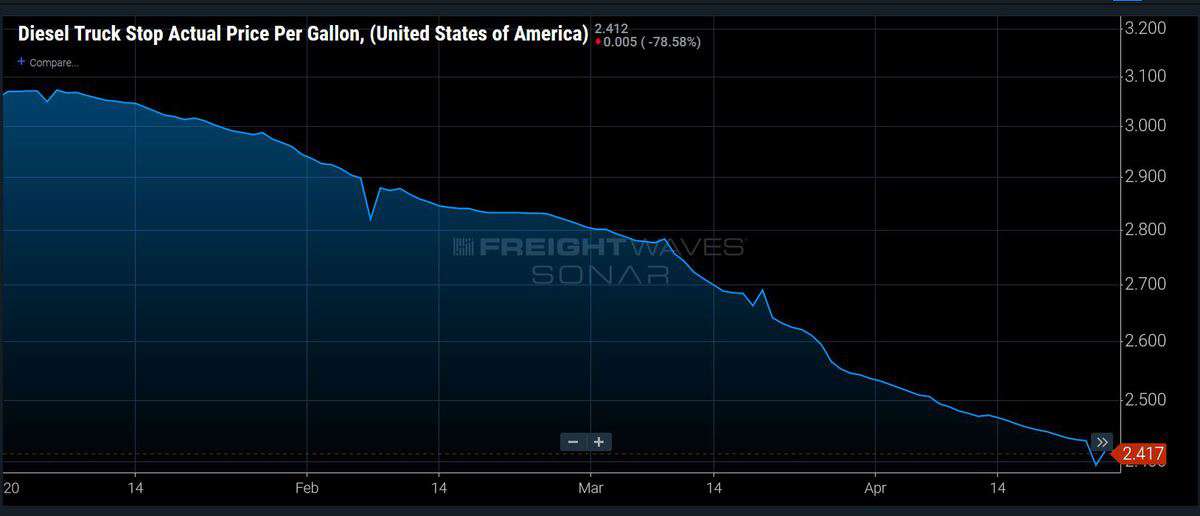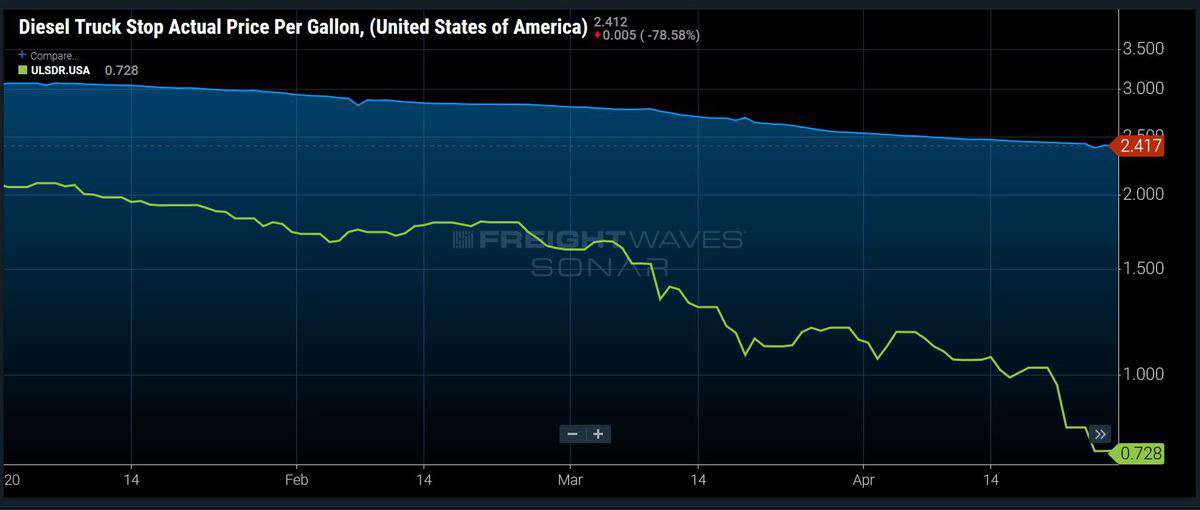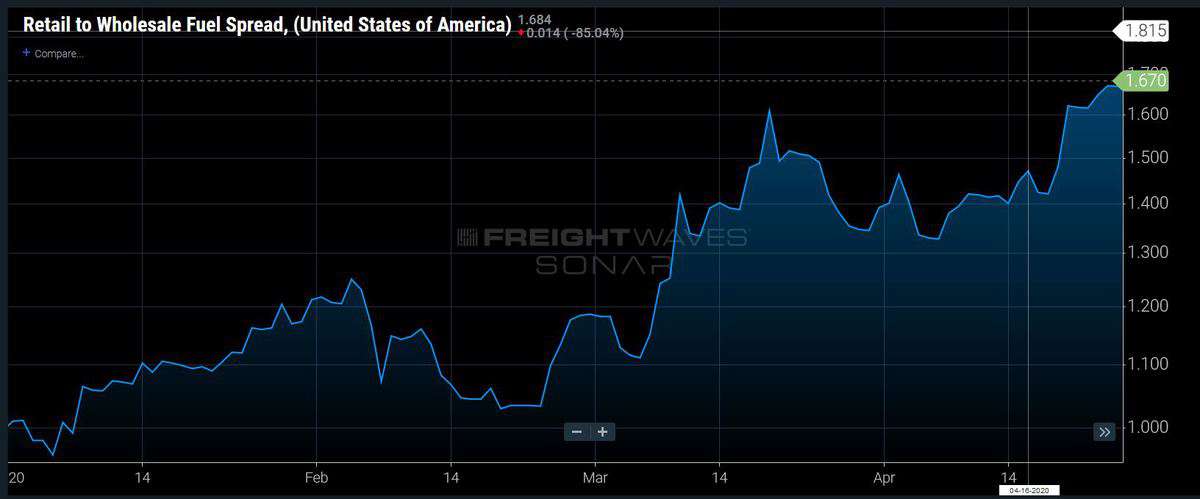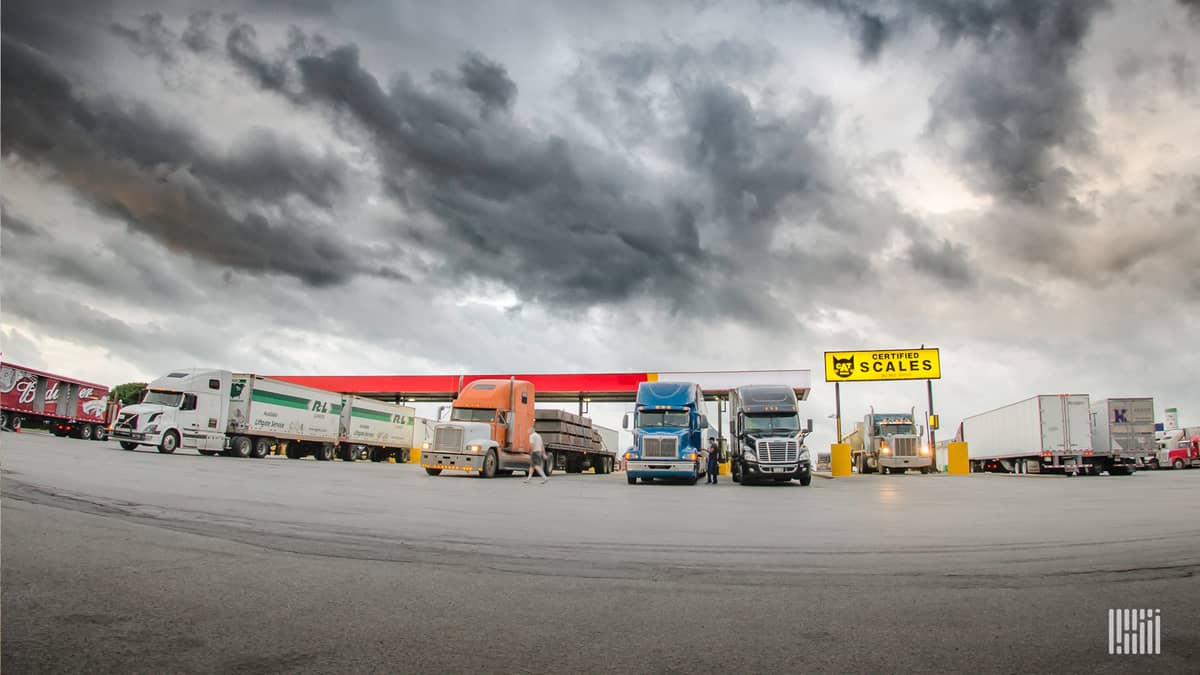If it feels to you like the price of diesel isn’t coming down as fast as it should, given all the focus on imploding oil prices, you’ve got a point.
A look at some key numbers by FreightWaves lends support to the argument that compared to other times of market weakness, the price at the pump is not falling as much as it has declined previously.
But one analysis we did not do was look at the price of diesel compared to the price of crude. Understandably, crude, with its drop down to negative numbers last week and its continuing slide this week albeit in positive territory, gets all the attention. But that’s not the analysis that ultimately needs to be observed.
Rather, trying to calculate whether retail diesel has fallen “enough” requires looking at how it and wholesale diesel are doing against various other markers, particularly those where human intervention isn’t part of the number. The open-market trading of ultra low sulfur diesel (ULSD) on the CME exchange involves volume measured in the hundreds of thousands of barrels, whereas retail and wholesale prices are produced with significant human involvement.
We’ll take the numbers step-by-step so as to not bury our readers with data. The final verdict is that retail has certainly fallen slower than it has in the past.
- The SONAR retail data price series, DTS.USA, as of April 27 was down 65.2 cents/gallon since January 1. That’s a drop of 21.27%. It stood at $3.0696/gallon on January 1 and on April 27 was $2.4167/g. That is the lowest it’s been all year.

- The weekly EIA/DOE retail price, the basis for fuel surcharges, is down 63.2 cents/gallon since the final posting of 2019. It was most recently at $2.437/g, down from the $3.069/g posted on December 30. That’s a drop of 20.4%. We would expect the DOE/EIA price and the DTS price to be close to each other. The latter is a survey of retail prices and the former is drawn from thousands of data points of prices at retail outlets.
- The first eyebrow-raising number is a comparison of the retail price to wholesale prices, known in the industry as the rack. SONAR has that national data in the ULSDR.USA series, along with regional data. Since January 1, the ULSDR.USA price is down $1.313/gallon. That’s a decline of 63.7%. The retail price, percentage-wise, is down just about one-third of that wholesale level. That price is an indication of what retailers pay to acquire their fuel, though the actual formulas have many other variables.

- To compare previous years, we need to look more at the relationship between the distillate contract on what used to be the NYMEX exchange and is now known as the CME exchange. CME acquired NYMEX in 2008. That contract used to be a heating oil contract; heating oil, like diesel is a distillate. It is now an ultra low sulfur diesel contract.
- Not surprisingly, the FUELS.USA data series in SONAR, which measured the price spread between DTS.USA and ULSDR.USA, has soared. It started the year at about $1. It’s up about 66 cents since then, which means it has jumped 65.3%.

- The numbers on two recent periods of sharp market decline are wildly different. For example, In the sharp falloff that began right around Labor Day 2014, by a low point in the cycle, January 26, 2015, the CME ULSD price had fallen 42%. But the weekly average retail diesel price had only declined 24.8%.That means the retail price had captured just under 60% of the CME price decline. But going back six years before that, in the sharp drop in price that began after the high-water market price of early July 2008, accelerated by the collapse of Lehman Brothers and the onset of the fiscal crisis, retail prices then tracked the decline in futures prices far more closely. Between early July and a somewhat arbitrary end of cycle date of March 23, 2009, the CME ULSD price was down 64.1%. The DOE diesel price was down 56.1%, almost matching the decline.
- How is retail diesel doing now compared to the fall in CME prices? As noted, the DOE price is down 20.4% from the last posting of December, far less than drop in wholesale prices. And not surprisingly, it’s far less than the decline in the CME price for ULSD, which is down $1.41/gallon, or just under 70% since the start of the year. That means retail diesel isn’t capturing even one-third of the decline in the commodity exchange price.
- One other factor in the market – the physical price of diesel has been sliding recently. This is the price in over-the-counter markets for physical diesel to be delivered usually in a fairly short time frame (as opposed to the CME contract, which is for one month ahead). Based on S&P Global Platts data, the spread between the price of a barge of ULSD in New York harbor and the world’s dated Brent crude benchmark has sunk to $11.71/barrel from $17.97/b at the start of the year. However, it should be noted that those declines are generally accounted for when rack prices are set. They are worth about 15 cents/gallon, given that weakening.
Looking at these numbers, there is no other conclusion that can be reached – retail diesel consumers at present are not getting the benefit of falling wholesale diesel prices. They rarely do. But what’s striking about this time is how little they are getting.
J. Scott Susich, director of data analytics and advisory services at the multi-commodity information firm of DTN, said of the data: “What you’re seeing is real.”
In an email to FreightWaves, Susich continued, “The short story here is wholesale/rack prices crashed along with the rest of the oil market, but retail has been really slow to come down. So the bottom line is their costs crashed and truck stops have reaped the benefit by allowing their margins to soar. “
One aspect of this price decline very different from the ones noted above is that the crash in consumption is tremendous. The fall in 2013-2016 was almost completely supply-driven, as supplies of oil from shale began to overwhelm the market. A few years earlier, the decline in 2008-2009 involved a weakening of demand that is a fraction of what the decline in world consumption now, that may reach 30%.
Keeping margins high in tough times is not new. As independent fuels consultant Gary Bevers recalled, much the same thing happened in the weeks as the Great Recession unfolded in 2008. Sales in convenience stores cratered and sometimes, a convenience store might have trouble making payroll. But prices were able to be kept high through August, the first full month of the price decline, “and everybody in the industry joked that they made their whole year’s budget in one month.” But Bevers added that the store owners didn’t take their money home with them; instead, “they paid their bank commitments.”
But that decline is minor compared to what they face now, Bevers said. A convenience store that might sell 20,000 gallons in a day is selling somewhere between 8,000 and 12,000 gallons now. However, that’s diesel; the drop in gasoline demand has been even harsher, he said.
In that sort of scenario, keeping diesel margins high is a survival tactic, Bevers said. “Whoever bleeds too much goes out of business,” he said.
In March, Travelcenters of America (NASDAQ: TA) did say that its diesel volumes had been “elevated” but said nothing about margins; that was at the time when stores were racing to restock their shelves and trucking volumes were soaring. TA will release its earnings May 5.
Susich said of the market for the sellers of diesel like TA, “In their partial defense, volumes have declined considerably, but I believe the truck stop industry is making more money today than before COVID-19 and the oil crash. Diesel volumes are down ~25% but margins have soared 100%. “











